2008 GMC SIERRA tow
[x] Cancel search: towPage 355 of 578
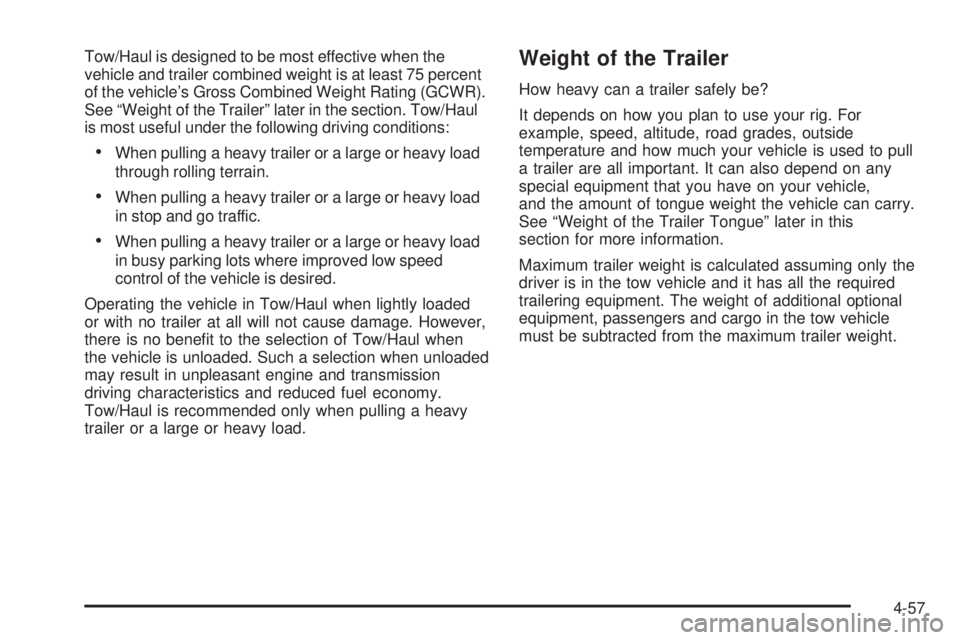
Tow/Haul is designed to be most effective when the
vehicle and trailer combined weight is at least 75 percent
of the vehicle’s Gross Combined Weight Rating (GCWR).
See “Weight of the Trailer” later in the section. Tow/Haul
is most useful under the following driving conditions:
When pulling a heavy trailer or a large or heavy load
through rolling terrain.
When pulling a heavy trailer or a large or heavy load
in stop and go traffic.
When pulling a heavy trailer or a large or heavy load
in busy parking lots where improved low speed
control of the vehicle is desired.
Operating the vehicle in Tow/Haul when lightly loaded
or with no trailer at all will not cause damage. However,
there is no bene�t to the selection of Tow/Haul when
the vehicle is unloaded. Such a selection when unloaded
may result in unpleasant engine and transmission
driving characteristics and reduced fuel economy.
Tow/Haul is recommended only when pulling a heavy
trailer or a large or heavy load.
Weight of the Trailer
How heavy can a trailer safely be?
It depends on how you plan to use your rig. For
example, speed, altitude, road grades, outside
temperature and how much your vehicle is used to pull
a trailer are all important. It can also depend on any
special equipment that you have on your vehicle,
and the amount of tongue weight the vehicle can carry.
See “Weight of the Trailer Tongue” later in this
section for more information.
Maximum trailer weight is calculated assuming only the
driver is in the tow vehicle and it has all the required
trailering equipment. The weight of additional optional
equipment, passengers and cargo in the tow vehicle
must be subtracted from the maximum trailer weight.
4-57
Page 358 of 578
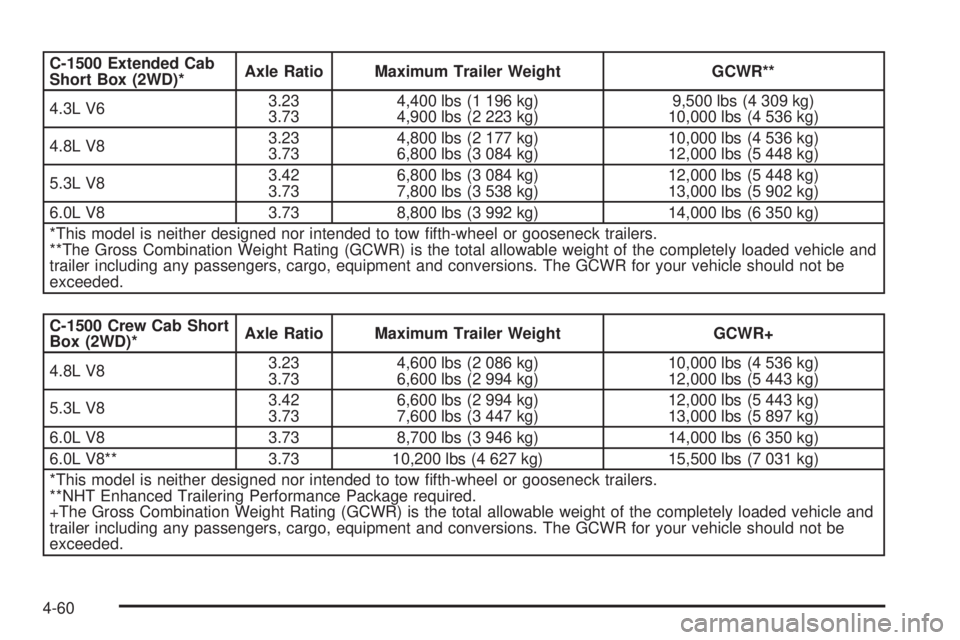
C-1500 Extended Cab
Short Box (2WD)*Axle Ratio Maximum Trailer Weight GCWR**
4.3L V63.23
3.734,400 lbs (1 196 kg)
4,900 lbs (2 223 kg)9,500 lbs (4 309 kg)
10,000 lbs (4 536 kg)
4.8L V83.23
3.734,800 lbs (2 177 kg)
6,800 lbs (3 084 kg)10,000 lbs (4 536 kg)
12,000 lbs (5 448 kg)
5.3L V83.42
3.736,800 lbs (3 084 kg)
7,800 lbs (3 538 kg)12,000 lbs (5 448 kg)
13,000 lbs (5 902 kg)
6.0L V8 3.73 8,800 lbs (3 992 kg) 14,000 lbs (6 350 kg)
*This model is neither designed nor intended to tow �fth-wheel or gooseneck trailers.
**The Gross Combination Weight Rating (GCWR) is the total allowable weight of the completely loaded vehicle and
trailer including any passengers, cargo, equipment and conversions. The GCWR for your vehicle should not be
exceeded.
C-1500 Crew Cab Short
Box (2WD)*Axle Ratio Maximum Trailer Weight GCWR+
4.8L V83.23
3.734,600 lbs (2 086 kg)
6,600 lbs (2 994 kg)10,000 lbs (4 536 kg)
12,000 lbs (5 443 kg)
5.3L V83.42
3.736,600 lbs (2 994 kg)
7,600 lbs (3 447 kg)12,000 lbs (5 443 kg)
13,000 lbs (5 897 kg)
6.0L V8 3.73 8,700 lbs (3 946 kg) 14,000 lbs (6 350 kg)
6.0L V8** 3.73 10,200 lbs (4 627 kg) 15,500 lbs (7 031 kg)
*This model is neither designed nor intended to tow �fth-wheel or gooseneck trailers.
**NHT Enhanced Trailering Performance Package required.
+The Gross Combination Weight Rating (GCWR) is the total allowable weight of the completely loaded vehicle and
trailer including any passengers, cargo, equipment and conversions. The GCWR for your vehicle should not be
exceeded.
4-60
Page 361 of 578
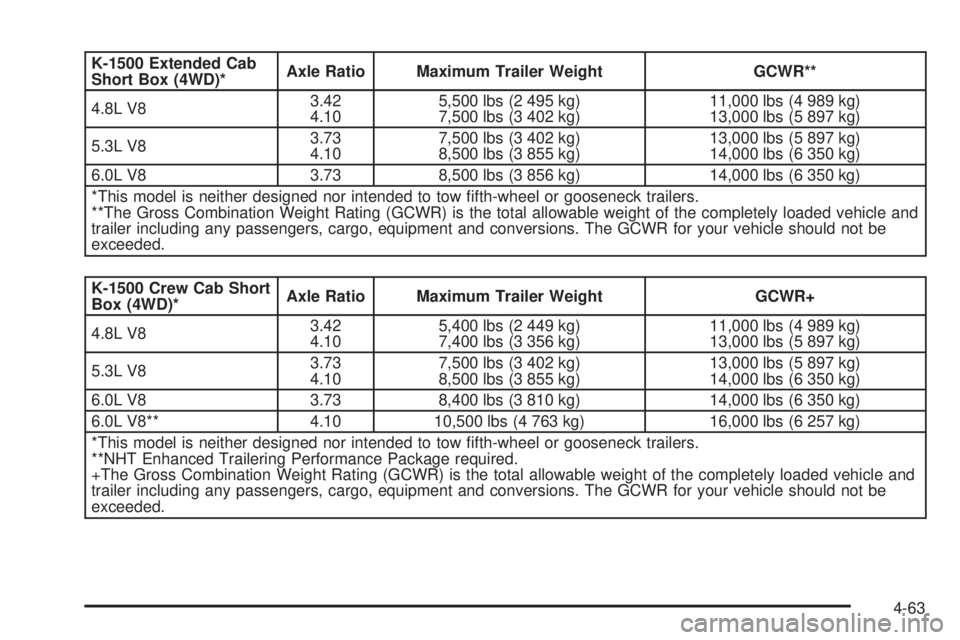
K-1500 Extended Cab
Short Box (4WD)*Axle Ratio Maximum Trailer Weight GCWR**
4.8L V83.42
4.105,500 lbs (2 495 kg)
7,500 lbs (3 402 kg)11,000 lbs (4 989 kg)
13,000 lbs (5 897 kg)
5.3L V83.73
4.107,500 lbs (3 402 kg)
8,500 lbs (3 855 kg)13,000 lbs (5 897 kg)
14,000 lbs (6 350 kg)
6.0L V8 3.73 8,500 lbs (3 856 kg) 14,000 lbs (6 350 kg)
*This model is neither designed nor intended to tow �fth-wheel or gooseneck trailers.
**The Gross Combination Weight Rating (GCWR) is the total allowable weight of the completely loaded vehicle and
trailer including any passengers, cargo, equipment and conversions. The GCWR for your vehicle should not be
exceeded.
K-1500 Crew Cab Short
Box (4WD)*Axle Ratio Maximum Trailer Weight GCWR+
4.8L V83.42
4.105,400 lbs (2 449 kg)
7,400 lbs (3 356 kg)11,000 lbs (4 989 kg)
13,000 lbs (5 897 kg)
5.3L V83.73
4.107,500 lbs (3 402 kg)
8,500 lbs (3 855 kg)13,000 lbs (5 897 kg)
14,000 lbs (6 350 kg)
6.0L V8 3.73 8,400 lbs (3 810 kg) 14,000 lbs (6 350 kg)
6.0L V8** 4.10 10,500 lbs (4 763 kg) 16,000 lbs (6 257 kg)
*This model is neither designed nor intended to tow �fth-wheel or gooseneck trailers.
**NHT Enhanced Trailering Performance Package required.
+The Gross Combination Weight Rating (GCWR) is the total allowable weight of the completely loaded vehicle and
trailer including any passengers, cargo, equipment and conversions. The GCWR for your vehicle should not be
exceeded.
4-63
Page 371 of 578
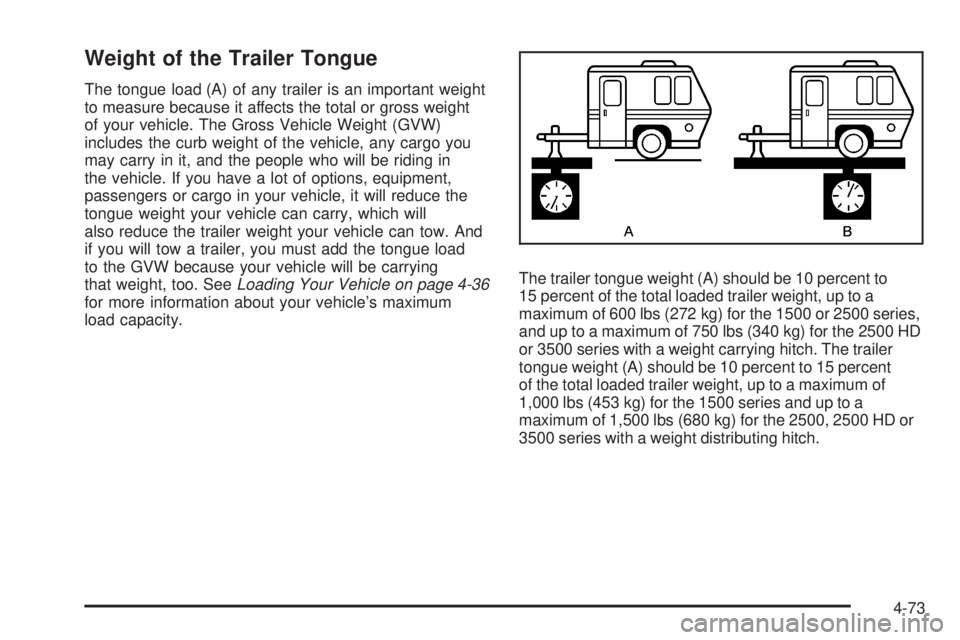
Weight of the Trailer Tongue
The tongue load (A) of any trailer is an important weight
to measure because it affects the total or gross weight
of your vehicle. The Gross Vehicle Weight (GVW)
includes the curb weight of the vehicle, any cargo you
may carry in it, and the people who will be riding in
the vehicle. If you have a lot of options, equipment,
passengers or cargo in your vehicle, it will reduce the
tongue weight your vehicle can carry, which will
also reduce the trailer weight your vehicle can tow. And
if you will tow a trailer, you must add the tongue load
to the GVW because your vehicle will be carrying
that weight, too. SeeLoading Your Vehicle on page 4-36
for more information about your vehicle’s maximum
load capacity.The trailer tongue weight (A) should be 10 percent to
15 percent of the total loaded trailer weight, up to a
maximum of 600 lbs (272 kg) for the 1500 or 2500 series,
and up to a maximum of 750 lbs (340 kg) for the 2500 HD
or 3500 series with a weight carrying hitch. The trailer
tongue weight (A) should be 10 percent to 15 percent
of the total loaded trailer weight, up to a maximum of
1,000 lbs (453 kg) for the 1500 series and up to a
maximum of 1,500 lbs (680 kg) for the 2500, 2500 HD or
3500 series with a weight distributing hitch.
4-73
Page 374 of 578
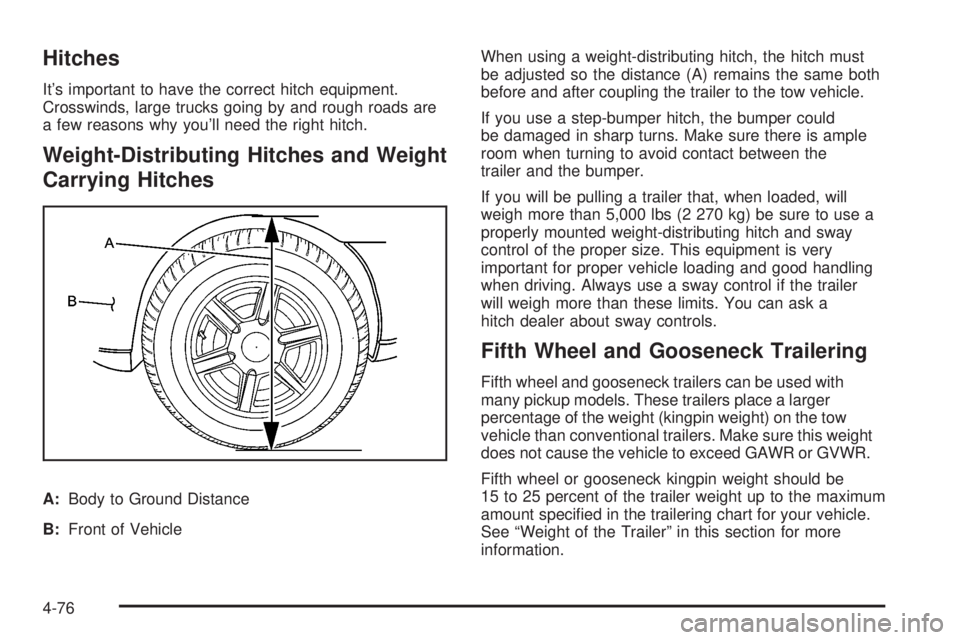
Hitches
It’s important to have the correct hitch equipment.
Crosswinds, large trucks going by and rough roads are
a few reasons why you’ll need the right hitch.
Weight-Distributing Hitches and Weight
Carrying Hitches
A:Body to Ground Distance
B:Front of VehicleWhen using a weight-distributing hitch, the hitch must
be adjusted so the distance (A) remains the same both
before and after coupling the trailer to the tow vehicle.
If you use a step-bumper hitch, the bumper could
be damaged in sharp turns. Make sure there is ample
room when turning to avoid contact between the
trailer and the bumper.
If you will be pulling a trailer that, when loaded, will
weigh more than 5,000 lbs (2 270 kg) be sure to use a
properly mounted weight-distributing hitch and sway
control of the proper size. This equipment is very
important for proper vehicle loading and good handling
when driving. Always use a sway control if the trailer
will weigh more than these limits. You can ask a
hitch dealer about sway controls.
Fifth Wheel and Gooseneck Trailering
Fifth wheel and gooseneck trailers can be used with
many pickup models. These trailers place a larger
percentage of the weight (kingpin weight) on the tow
vehicle than conventional trailers. Make sure this weight
does not cause the vehicle to exceed GAWR or GVWR.
Fifth wheel or gooseneck kingpin weight should be
15 to 25 percent of the trailer weight up to the maximum
amount speci�ed in the trailering chart for your vehicle.
See “Weight of the Trailer” in this section for more
information.
4-76
Page 375 of 578
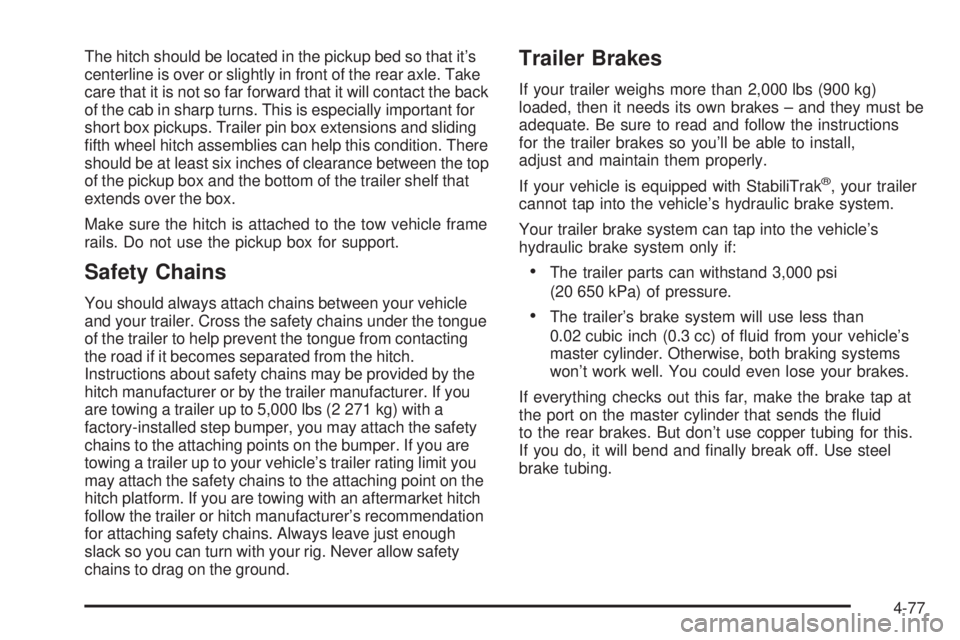
The hitch should be located in the pickup bed so that it’s
centerline is over or slightly in front of the rear axle. Take
care that it is not so far forward that it will contact the back
of the cab in sharp turns. This is especially important for
short box pickups. Trailer pin box extensions and sliding
�fth wheel hitch assemblies can help this condition. There
should be at least six inches of clearance between the top
of the pickup box and the bottom of the trailer shelf that
extends over the box.
Make sure the hitch is attached to the tow vehicle frame
rails. Do not use the pickup box for support.
Safety Chains
You should always attach chains between your vehicle
and your trailer. Cross the safety chains under the tongue
of the trailer to help prevent the tongue from contacting
the road if it becomes separated from the hitch.
Instructions about safety chains may be provided by the
hitch manufacturer or by the trailer manufacturer. If you
are towing a trailer up to 5,000 lbs (2 271 kg) with a
factory-installed step bumper, you may attach the safety
chains to the attaching points on the bumper. If you are
towing a trailer up to your vehicle’s trailer rating limit you
may attach the safety chains to the attaching point on the
hitch platform. If you are towing with an aftermarket hitch
follow the trailer or hitch manufacturer’s recommendation
for attaching safety chains. Always leave just enough
slack so you can turn with your rig. Never allow safety
chains to drag on the ground.
Trailer Brakes
If your trailer weighs more than 2,000 lbs (900 kg)
loaded, then it needs its own brakes – and they must be
adequate. Be sure to read and follow the instructions
for the trailer brakes so you’ll be able to install,
adjust and maintain them properly.
If your vehicle is equipped with StabiliTrak
®, your trailer
cannot tap into the vehicle’s hydraulic brake system.
Your trailer brake system can tap into the vehicle’s
hydraulic brake system only if:
The trailer parts can withstand 3,000 psi
(20 650 kPa) of pressure.
The trailer’s brake system will use less than
0.02 cubic inch (0.3 cc) of �uid from your vehicle’s
master cylinder. Otherwise, both braking systems
won’t work well. You could even lose your brakes.
If everything checks out this far, make the brake tap at
the port on the master cylinder that sends the �uid
to the rear brakes. But don’t use copper tubing for this.
If you do, it will bend and �nally break off. Use steel
brake tubing.
4-77
Page 377 of 578

{CAUTION:
Connecting a trailer that is not compatible with
the ITBC system may result in reduced or
complete loss of trailer braking. There may be
an increase in stopping distance or trailer
instability which could result in personal injury
or damage to your vehicle, trailer, or other
property. An aftermarket controller may be
available for use with trailers with surge, air or
electric-over-hydraulic trailer brake systems.
To determine the type of brakes on your trailer
and the availability of controllers, check with
your trailer manufacturer or dealer.When trailering, make sure of the following:
The ITBC system is used only with trailers that are
equipped with electric brakes.
All applicable local and federal laws and regulations
are followed.
All electrical and mechanical connections to the
trailer are made correctly.
The trailer’s brakes are in proper working condition.
The trailer and vehicle are properly loaded for
the towing condition.
The ITBC system is a factory installed item.
Out-of-factory installation of this system should not be
attempted. GM is not responsible for warranty or
performance of the system resulting from out-of-factory
installation.
4-79
Page 381 of 578
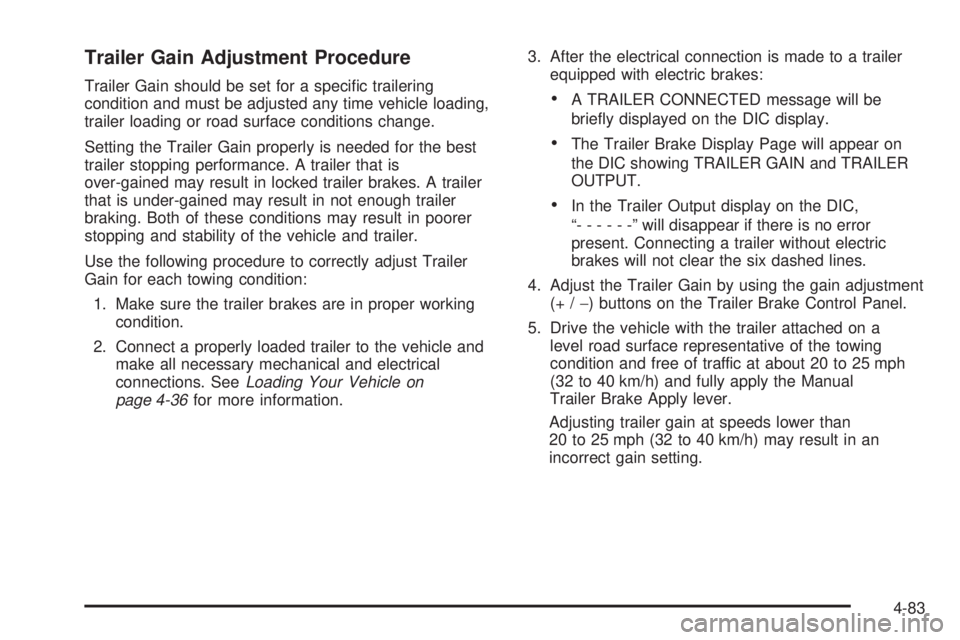
Trailer Gain Adjustment Procedure
Trailer Gain should be set for a speci�c trailering
condition and must be adjusted any time vehicle loading,
trailer loading or road surface conditions change.
Setting the Trailer Gain properly is needed for the best
trailer stopping performance. A trailer that is
over-gained may result in locked trailer brakes. A trailer
that is under-gained may result in not enough trailer
braking. Both of these conditions may result in poorer
stopping and stability of the vehicle and trailer.
Use the following procedure to correctly adjust Trailer
Gain for each towing condition:
1. Make sure the trailer brakes are in proper working
condition.
2. Connect a properly loaded trailer to the vehicle and
make all necessary mechanical and electrical
connections. SeeLoading Your Vehicle on
page 4-36for more information.3. After the electrical connection is made to a trailer
equipped with electric brakes:A TRAILER CONNECTED message will be
brie�y displayed on the DIC display.
The Trailer Brake Display Page will appear on
the DIC showing TRAILER GAIN and TRAILER
OUTPUT.
In the Trailer Output display on the DIC,
“------”will disappear if there is no error
present. Connecting a trailer without electric
brakes will not clear the six dashed lines.
4. Adjust the Trailer Gain by using the gain adjustment
(+ /−) buttons on the Trailer Brake Control Panel.
5. Drive the vehicle with the trailer attached on a
level road surface representative of the towing
condition and free of traffic at about 20 to 25 mph
(32 to 40 km/h) and fully apply the Manual
Trailer Brake Apply lever.
Adjusting trailer gain at speeds lower than
20 to 25 mph (32 to 40 km/h) may result in an
incorrect gain setting.
4-83